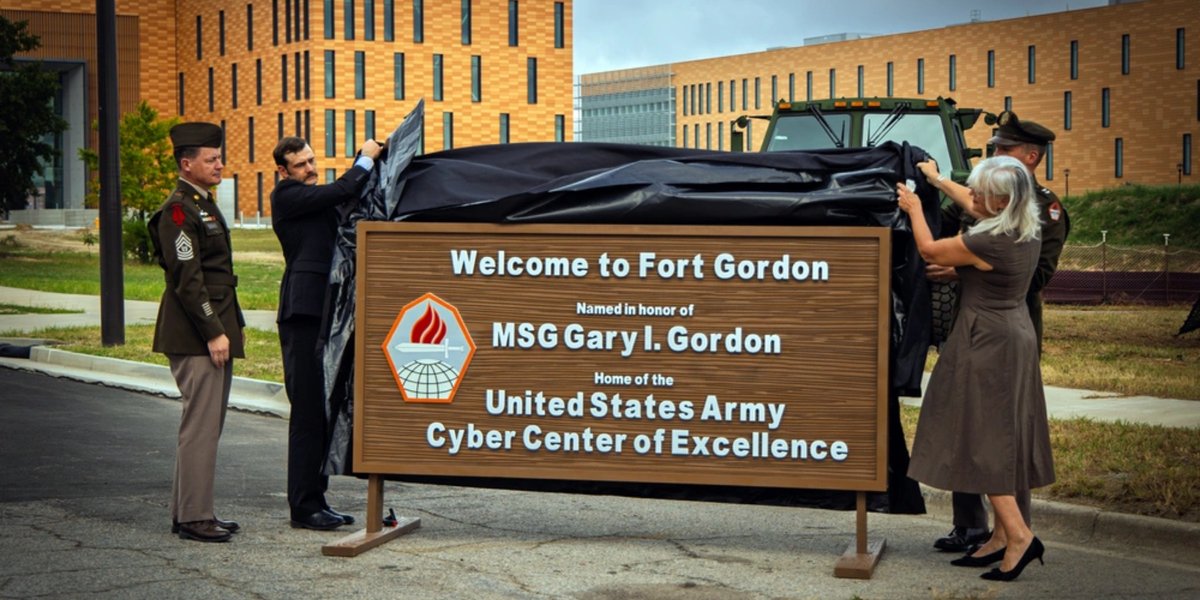FORT GORDON RENAMED AFTER MSGT GARY GORDON, MEDAL OF HONOR HERO

In recent years, the back-and-forth efforts to change the names of the nine US Army installations named after Confederate officers who fought against and killed US troops have stirred up plenty of controversy across the political spectrum.
But recently, the Army formally rededicated one of its largest installations, Fort Gordon, Georgia, to an undeniably heroic American. A soldier whose career and tragically short life earned him status as a legend in the pantheon of the brave men and women who gave their lives for their country: Master Sergeant Gary I. Gordon, a Delta Force sniper and one of the heroes of the 1993 Battle of Mogadishu.
Historical Names of Fort Gordon
Established in the summer of 1941 to train soldiers with the expectation that America would likely enter World War II before long, Fort Gordon was named after John Brown Gordon.
The Georgia-born Gordon, who never served in any branch of the US military, joined the Confederate Army during the Civil War, eventually rising to the rank of lieutenant general. After the war, he spent several decades in politics, serving as a US senator and governor of his home state. An avid white supremacist and opponent of Reconstruction, it’s widely believed he was the leader, or “Grand Dragon,” of the Ku Klux Klan for all of Georgia.
When the base was, understandably, renamed in October of 2023, its new namesake was far more deserving of the honor of sharing his name with an Army base: Retired General and 34th President of the United States Dwight David “Ike” Eisenhower. A West Point graduate, his thirty-three-year active duty career in the Army included serving as the supreme commander of Allied forces in Western Europe for the last few years of WWII.
In 1944, he received a temporary promotion to five-star “General of the Army,” a rank held only by four other men in American history. He went on to serve two terms in the White House from 1953 to 1961, during which time he, among other things, ensured the desegregation of the Armed Forces and both proposed and signed the Civil Rights Acts of 1957 and 1960 (moves which the base’s original namesake would certainly not appreciate). All in all, Eisenhower was an obvious choice to replace John Gordon, though the name change would be a brief one.
MSgt Gary Gordon: Medal of Honor Recipient
Born in the small town of Lincoln, Maine, in 1960, Gary Ivan Gordon joined the US Army at age eighteen, a few months after graduating high school. After serving as a combat engineer and then a Special Forces Engineer with the 10th Special Forces Group, Gordon was selected for the Army’s secretive and ultra-elite 1st Special Forces Operational Detachment-Delta (1SFOD-D), more commonly known as Delta Force.
He took part in the 1989 invasion of Panama and advanced to the rank of Master Sergeant. In 1993, Gordon and other members of Delta Force joined the US-led military operation deployed to Somalia in support of international efforts to provide humanitarian aid and peacekeeping efforts during that nation’s civil war.
MSgt Gary Gordon's Role in Black Hawk Down
On October 3rd, 1993, the Task Force Ranger, a combined unit of US Army Rangers, special forces operators, and helicopters of the 160th Special Operations Aviation Regiment, supported by soldiers of the 10th Mountain Division, set out to capture a Somali warlord named Muhammad Farah Aydid.
As the man most responsible for preventing proper distribution of humanitarian aid to the Somali people, the military deemed it essential that he be taken into custody. The mission, Operation Gothic Serpent, was planned as a quick snatch-and-grab. But it fell apart quickly as local militants shot down two UH-60 Black Hawk helicopters with rocket-propelled grenades within twenty minutes of each other. With the rescue effort already focused on the first downed aircraft, the situation for the crew of the second one (dubbed “Super Six Four”) looked grim.
Hovering above them, another Black Hawk carried three Delta Force snipers providing cover: MSgt Gordon and Sergeants First Class Randy Shugart and Brad Halling. Seeing a mob of local militia descending on the downed helo, Gordon requested permission to defend the crash site from the ground. After being denied several times, he finally received approval. Gordon and Shugart descended the helicopter via rope while Halling provided additional cover with one of the aircraft’s door-mounted miniguns (albeit only for a short time, as an RPG damaged the helicopter and severed Halling’s left leg).
After pulling Super Six Four’s crew from the wreckage, the two snipers did their utmost to defend their comrades from the enemy forces vastly outnumbering them for as long as they could. With their ammunition low, three of the four crewmen dead from their crash injuries, and Shugart fatally wounded, Gordon handed a rifle (his own or one recovered from the Black Hawk, depending on the account) to the lone survivor (Warrant Officer Michael Durant), wished him “Good luck,” and fought on with his sidearm until he, too, received a fatal wound.
Operation Gothic Serpent failed to capture Aydid and ended with 18 American troops, in addition to unknown numbers of Somali militants and civilians, dead. For their actions that day, Gordon and Shugart both posthumously received the Medal of Honor, the first people to earn the award since the Vietnam War. Despite the loss of his leg, Halling remained on active duty until he retired as a Sergeant Major in 2000. Durant, captured by the militia, spent eleven days in captivity before his release, after which he returned to flying for the 160th until his retirement in 2001.
These men, and the others who took part in the operation, gained national recognition with the publication of journalist Mark Bowden’s 1999 book about it, Black Hawk Down: A Story of Modern War. That recognition grew again with the 2001 release of the hit film based on Bowden’s book, directed by Ridley Scott and featuring Ron Eldard as Durant, Johnny Strong as Shugart, and Danish actor Nikolaj Coster-Waldau (of later Game of Thrones fame) as Gordon (Halling was not depicted).
Renaming Fort Gordon to Honor MSgt Gary Gordon
Choosing MSgt Gordon as the man to replace President Eisenhower as the fort’s namesake is part of President Donald Trump and the Secretary of Defense/War’s decision to return seven of the nine recently renamed Army installations to their previous designations. Though these renamings are being made in honor of servicemembers with identical last and, in some cases, first names as their original eponymous traitors. While that decision has stirred some controversy and provoked negative responses, nobody can argue that the late Master Sergeant Gary Gordon is unworthy of an Army base bearing his name.
Suggested reads:
Paul Mooney
Veteran & Military Affairs Correspondent at MyBaseGuide
Paul D. Mooney is an award-winning writer, filmmaker, and former Marine Corps officer (2008–2012). He brings a unique perspective to military reporting, combining firsthand service experience with exp...
Paul D. Mooney is an award-winning writer, filmmaker, and former Marine Corps officer (2008–2012). He brings a unique perspective to military reporting, combining firsthand service experience with exp...
Credentials
- Former Marine Corps Officer (2008-2012)
- Award-winning writer and filmmaker
- USGS Public Relations team member
Expertise
- Military Affairs
- Military History
- Defense Policy
SHARE:



